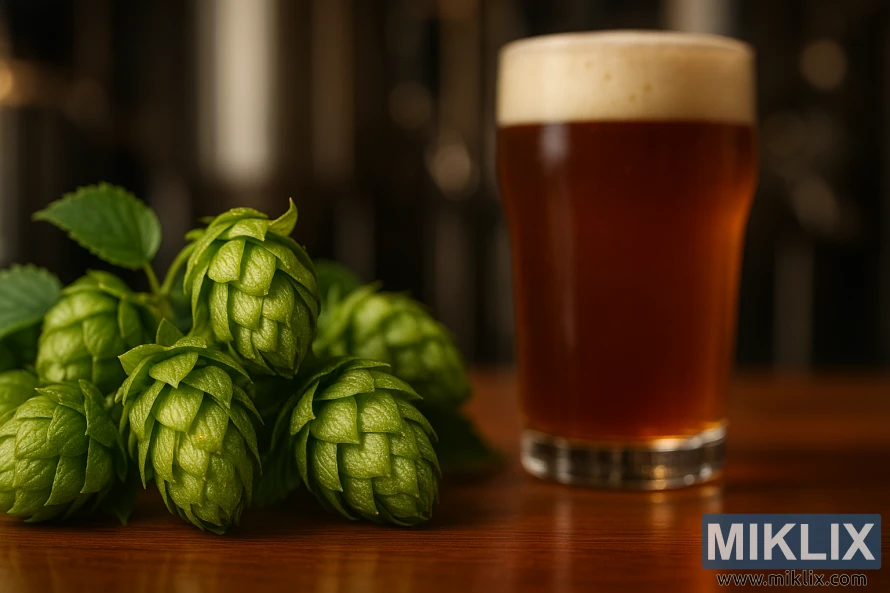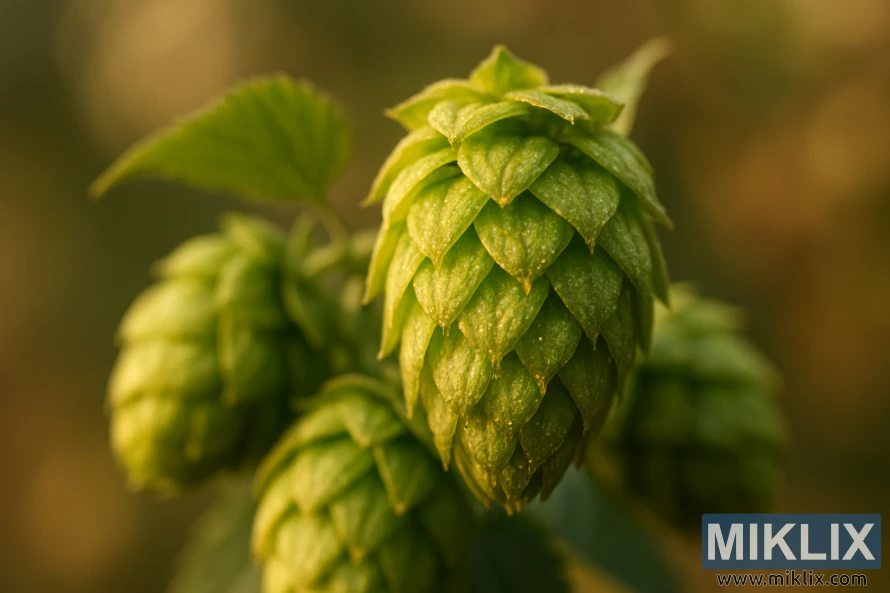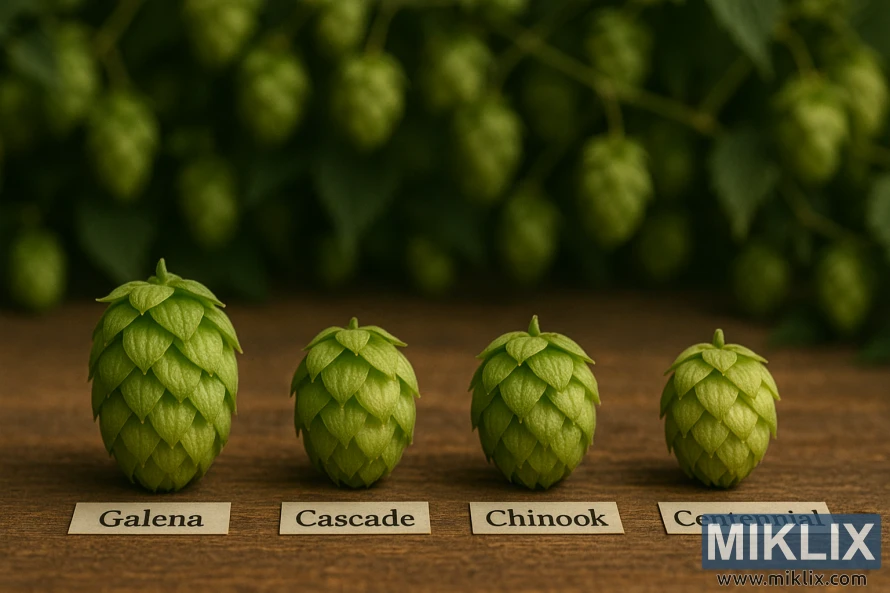Hops in Beer Brewing: Galena
Published: July 26, 2025 at 7:24:58 AM UTC
Beer brewing is an art that requires a variety of ingredients, with hops being a key component. Among these, Galena Hops are notable for their distinct characteristics. Originating in the US, Galena Hops are widely used for bittering. They are known for their clean and pungent flavor profile. This makes them a preferred choice among brewers. Understanding the role of Galena Hops in brewing is essential for creating high-quality beers. This article will explore their characteristics, uses, and benefits in the brewing process.

Key Takeaways
- Galena Hops are a popular choice for bittering in US beer brewing.
- They offer a clean and pungent flavor profile.
- Understanding their characteristics is essential for brewers.
- Galena Hops are used for their bittering properties.
- Their unique attributes make them a preferred hop variety.
Introduction to Galena Hops
Galena Hops, renowned for their high alpha acid content, were developed in the late 1960s in Idaho. They were introduced to the public in 1978, starting their journey in the brewing world. Known for their bittering properties, Galena Hops have become a cornerstone in brewing. Their versatility and unique characteristics make them a favorite among brewers.
These hops are part of a wide array of varieties used in brewing. Their creation aimed to fulfill multiple roles in the brewing process. This includes bittering, adding flavor, and contributing to the aroma. The history of Galena Hops is deeply intertwined with the growth of the brewing industry, mainly in the United States.
Galena Hops stand out with an alpha acid content of 12% to 14%. This high content makes them ideal for bittering in brewing. While their flavor and aroma might not be as complex as some other varieties, their popularity among brewers is undeniable.
- High alpha acid content (12-14%)
- Versatile for various brewing applications
- Bred in Idaho in the late 1960s
- Released to the public in 1978
For brewers, understanding Galena Hops is key to leveraging their unique properties. As the brewing industry advances, Galena Hops continue to play a vital role. They are essential in crafting a broad spectrum of beer styles.
Chemical Composition and Properties
Galena Hops stand out for their unique chemical makeup, which greatly affects their bittering abilities. With an alpha acid content between 12% and 14%, they are ideal for brewers aiming to create beers with a strong bitterness.
The high alpha acid content is a hallmark of Galena Hops. Alpha acids are key to hops' bittering, and a higher amount results in a more intense bitterness. This makes them perfect for beers needing a bold bitter taste.
Beyond alpha acids, Galena Hops also contain beta acids. These contribute to the hops' overall flavor and aroma. While beta acids have a less direct impact on bitterness, they are vital for the hop's complex flavor and aroma.
- Alpha acid content: 12-14%
- High bittering capacity
- Rich flavor and aroma from beta acids
The distinct chemical makeup of Galena Hops makes them adaptable for many brewing needs. Their high alpha acid and beta acid content lead to a complex flavor profile. This can elevate a wide variety of beer styles.
Aroma and Flavor Profile of Galena Hops
Galena Hops are celebrated for their rich aroma and flavor, making them a go-to for brewers. Their unique traits enhance a variety of beer styles, adding depth to both flavor and aroma.
The flavor profile of Galena Hops is diverse. Notable flavors include sweet fruits, pear, and pineapple. These notes make Galena Hops a favorite for brewers seeking to infuse their beers with fruity and slightly sweet undertones.
The aroma of Galena Hops is equally complex. It offers a blend of herbal and fruity notes, enriching the beer's character.
In brewing, Galena Hops bring complexity to various beer styles. Their robust flavor profile is ideal for bittering, late addition, and dry hopping techniques.
The versatility of Galena Hops stems from their balanced chemical makeup. This balance includes alpha acids, beta acids, and essential oils. This combination is key to their complex aroma and flavor, making them a standout choice for brewers.

Growing Conditions and Cultivation
Galena Hops, bred in Idaho, flourish in dry climates with low humidity. The dry conditions contribute to their high alpha acid content and robust flavor profile.
The ideal climate for growing Galena Hops includes warm summers and cold winters. This slow maturation process enhances their aroma and bitterness.
Galena Hops need well-drained soil with a pH between 6.0 and 7.0. They also require adequate sunlight and irrigation for healthy growth and high yields.
- Cultivation requirements include regular pruning and training of the hop bines.
- Farmers must also monitor for pests and diseases, taking action as necessary to prevent damage.
- Soil quality and moisture levels are critical factors in the successful cultivation of Galena Hops.
The growing conditions and cultivation practices for Galena Hops directly impact their quality and yield. By understanding and optimizing these factors, brewers can ensure a consistent supply of high-quality Galena Hops for their beers.
Harvesting and Processing Methods
To maximize the Galena Hops' full flavor, it's key to grasp their harvesting and processing. These hops are usually picked in mid-to-late August. This is when the cones are fully ripe and the alpha acids reach their highest levels.
The harvesting process starts with cutting the hop bines. Then, the cones are dried, and the hops are separated from leaves and stems. It's critical to dry the hops properly to keep their flavor and aroma intact.
Processing methods, like pelletizing or plug formation, also affect the final product's quality. Pellets are created by grinding dried hops into a fine powder and then compressing them into small pellets. This method helps keep the hops' natural oils and resins intact.
Understanding effective harvesting and processing techniques is essential for maintaining the high quality and unique flavor of Galena Hops. By learning about these methods, brewers can appreciate the skill that goes into producing top-notch hops for brewing.
Comparing Galena Hops with Other Varieties
In the realm of beer brewing, grasping the nuances between Galena Hops and other varieties is essential. Galena Hops are frequently compared to Brewer's Gold and Chinook due to their shared traits and applications.
Galena Hops stand out with their distinct characteristics. Notably, their alpha acid content is high, making them ideal for bittering.
When comparing Galena Hops to Brewer's Gold, both boast high alpha acid content. Yet, Galena Hops offer a cleaner flavor. In contrast, Chinook hops are known for their robust pine aroma, differing from Galena's subtler traits.
- Galena Hops: High alpha acid content, clean flavor profile
- Brewer's Gold: High alpha acid content, robust flavor
- Chinook: High alpha acid content, pronounced pine aroma
Galena Hops' unique attributes make them a versatile choice for brewers. They excel in both bittering and flavor/aroma roles, though they're mainly used for bittering.
Compared to other high-alpha acid hops, Galena Hops provide a consistent bittering profile. This reliability makes them a preferred choice among commercial brewers. Their versatility and distinct characteristics enrich many beer recipes.

Bittering Applications in Brewing
Galena Hops stand out for their high alpha acid content, making them a top pick for bittering in brewing. Their alpha acid content usually falls between 12% to 15%. This is much higher than many other hop varieties. This high content allows brewers to achieve the desired bitterness with less hops.
The bittering properties of Galena Hops not only add bitterness to the beer but also subtly influence flavor and aroma. Used for bittering, they provide a clean bitterness without harsh aftertastes. This makes them suitable for a wide range of beer styles.
- Galena Hops are ideal for brewers seeking a clean bitterness.
- Their high alpha acid content makes them efficient for bittering.
- They are versatile and can be used in various beer styles, from IPAs to stouts.
In brewing, the timing of hop additions is key. For bittering, Galena Hops are added early in the boil. This allows the alpha acids to isomerize and contribute to the beer's bitterness. This process is vital for achieving a balanced flavor profile.
Late Addition and Dry Hopping Techniques
The use of Galena Hops in late addition and dry hopping can significantly enhance the flavor and aroma of beer. These techniques allow brewers to capitalize on the unique characteristics of Galena Hops. They add depth and complexity to their brews.
Late addition involves adding hops to the brew near the end of the boiling process. This helps preserve the delicate flavor and aroma compounds. Galena Hops, with their distinct profile, can contribute a subtle yet noticeable impact when used in this manner.
Dry hopping, on the other hand, involves adding hops to the beer after fermentation. Often, this is done by adding them to the brew in a secondary fermenter or directly into kegs. This technique is effective for imparting a fresh, hoppy aroma to the beer. Galena Hops can be used for dry hopping to introduce a unique twist to the beer's flavor profile.
By incorporating Galena Hops into late addition and dry hopping techniques, brewers can create beers with enhanced flavor and aroma characteristics. These methods are valuable tools in the pursuit of brewing excellence.
Commercial Brewing Applications
Galena Hops are widely used in commercial brewing, adding to a variety of beer styles. Their high alpha acid content makes them perfect for bittering in beers like American Pale Ales and IPAs.
Commercial breweries value Galena Hops for their versatility and consistent flavor. They are used in different brewing steps, including bittering, flavor, and aroma additions. The bitterness they add is clean and crisp, a key feature in many beer styles.
The widespread use of Galena Hops in commercial brewing highlights their quality and value. As the craft brewing industry grows, the demand for high-quality hops like Galena is expected to stay strong.
Home Brewing with Galena Hops
Home brewing enthusiasts can greatly benefit from Galena Hops. They bring a crisp, clean bitterness to their brews. Known for their high alpha acid content, Galena Hops are perfect for bittering in various beer styles.
When brewing with Galena Hops, timing is key. For bittering, add them early in the boil to maximize their alpha acid contribution. For flavor and aroma, add them later, typically within the last 15 minutes of the boil.
Here are some tips for incorporating Galena Hops into your home brewing routine:
- Use Galena Hops for bittering additions to take advantage of their high alpha acid content.
- Experiment with later hop additions for unique flavor and aroma profiles.
- Consider blending Galena Hops with other hop varieties to create complex hop profiles.
By following these techniques and tips, home brewers can effectively utilize Galena Hops to enhance their beers. Whether brewing a classic IPA or trying a new recipe, Galena Hops can add a unique dimension to your home brews.
Recipe Development Guidelines
Understanding the unique flavor and aroma of Galena Hops is key when developing recipes. These hops are versatile, fitting well in various beer styles. This includes American Pale Ales and IPAs.
To craft complex and balanced beers, brewers should mix Galena Hops with other varieties. Pairing them with Cascade or Centennial hops can boost the beer's aroma and taste. It's important to grasp how Galena's alpha acid content and flavor interact with other ingredients.
When experimenting with Galena Hops, think about the bitterness, flavor, and aroma you want in your beer. Balancing these aspects allows you to create unique and tasty brews. These will highlight the best qualities of Galena Hops.
Common Brewing Challenges and Solutions
Brewing with Galena Hops can be rewarding but also comes with challenges. One major concern is over-bittering due to their high alpha acid content. Brewers must carefully monitor hop amounts during brewing to avoid this.
Another challenge is achieving the desired flavor and aroma. Galena Hops have a clean, neutral taste, which suits some beer styles but not others. To overcome this, brewers can experiment with different hop combinations to find the perfect balance for their recipe.
Here are some tips for overcoming common brewing challenges when using Galena Hops:
- Carefully measure hop quantities to avoid over-bittering.
- Experiment with different hop varieties to achieve the desired flavor and aroma.
- Monitor brewing conditions, such as temperature and pH, to ensure optimal hop utilization.
By understanding the challenges of Galena Hops and implementing these solutions, brewers can create high-quality beers. These beers will showcase the unique characteristics of this versatile hop variety.

Storage and Preservation Best Practices
To keep Galena Hops in top condition, it's essential to adhere to the best storage and preservation methods. Known for their durability, Galena Hops retain their alpha acids for a considerable period. Yet, proper care and storage are necessary to preserve their distinct flavor and aroma.
For storing Galena Hops, a cool, dry environment is critical. This slows down degradation and keeps the hops' natural oils and resins intact. The ideal storage temperature is below 40°F (4°C). It's also important to keep them away from direct sunlight and moisture.
- Store hops in airtight containers or vacuum-sealed bags to prevent exposure to air and moisture.
- Keep hops away from strong-smelling foods and chemicals, as they can absorb odors easily.
- Label and date the stored hops to ensure that the oldest stock is used first.
By adhering to these storage and preservation best practices, brewers can maintain the flavor and aroma of Galena Hops. This ensures their beers meet the desired standards. Proper storage and handling of Galena Hops are key to achieving consistent brewing results.
Substitutes and Alternatives
Galena Hops stand out due to their unique traits. Yet, other hop varieties can serve as substitutes in brewing. Brewers look at alpha acid content, aroma profile, and flavor impact when choosing alternatives.
Brewer's Gold and Chinook are popular substitutes for Galena Hops. Brewer's Gold is high in alpha acids, ideal for bittering. Chinook adds a pine and spice flavor, enriching beer complexity.
- Nugget Hops, with high alpha acid content like Galena Hops.
- Columbus Hops, versatile for both bittering and aroma.
- Centennial Hops, known for balanced flavor and aroma.
When substituting Galena Hops, brewers must consider the alternative variety's characteristics. This might involve adjusting quantity or hop addition timing in the brewing process.
Future Trends and Market Outlook
The craft beer industry is evolving rapidly, with a growing demand for unique hop varieties like Galena Hops. Craft brewers are always on the lookout for ways to stand out, and Galena Hops' distinct bittering profile is highly sought after.
The market outlook for Galena Hops is optimistic, fueled by the increasing popularity of craft beer and hop-forward styles. Reports indicate that Galena Hops are in high demand, appealing to craft brewers who appreciate their unique characteristics.
Looking ahead, Galena Hops are set to remain a key player in the brewing industry. Their versatility and unique flavor profile make them a favorite among brewers eager to innovate and explore new beer styles.
- Increasing demand for craft beer
- Growing popularity of hop-forward beer styles
- Rising demand for unique hop varieties like Galena Hops
In summary, the future of Galena Hops appears promising, with a steady increase in demand and a favorable market outlook. As the craft beer industry continues to grow, Galena Hops are likely to remain a top choice among brewers.

Conclusion
Galena Hops have emerged as a versatile and valuable addition to beer brewing. They bring a unique flavor and aroma to the table. This article has delved into their characteristics, growing conditions, and brewing applications.
Galena Hops are ideal for bittering due to their high alpha acid content. They also excel in late addition and dry hopping, boosting beer's flavor and aroma. By mastering the use of Galena Hops, brewers can craft a variety of beer styles with unique profiles.
This article serves as a detailed guide for incorporating Galena Hops into brewing. It empowers brewers to explore new recipes and techniques. As the craft brewing scene expands, the need for premium hops like Galena will persist. This demand will fuel innovation and growth in the industry.
Further Reading
If you enjoyed this post, you may also like these suggestions:
